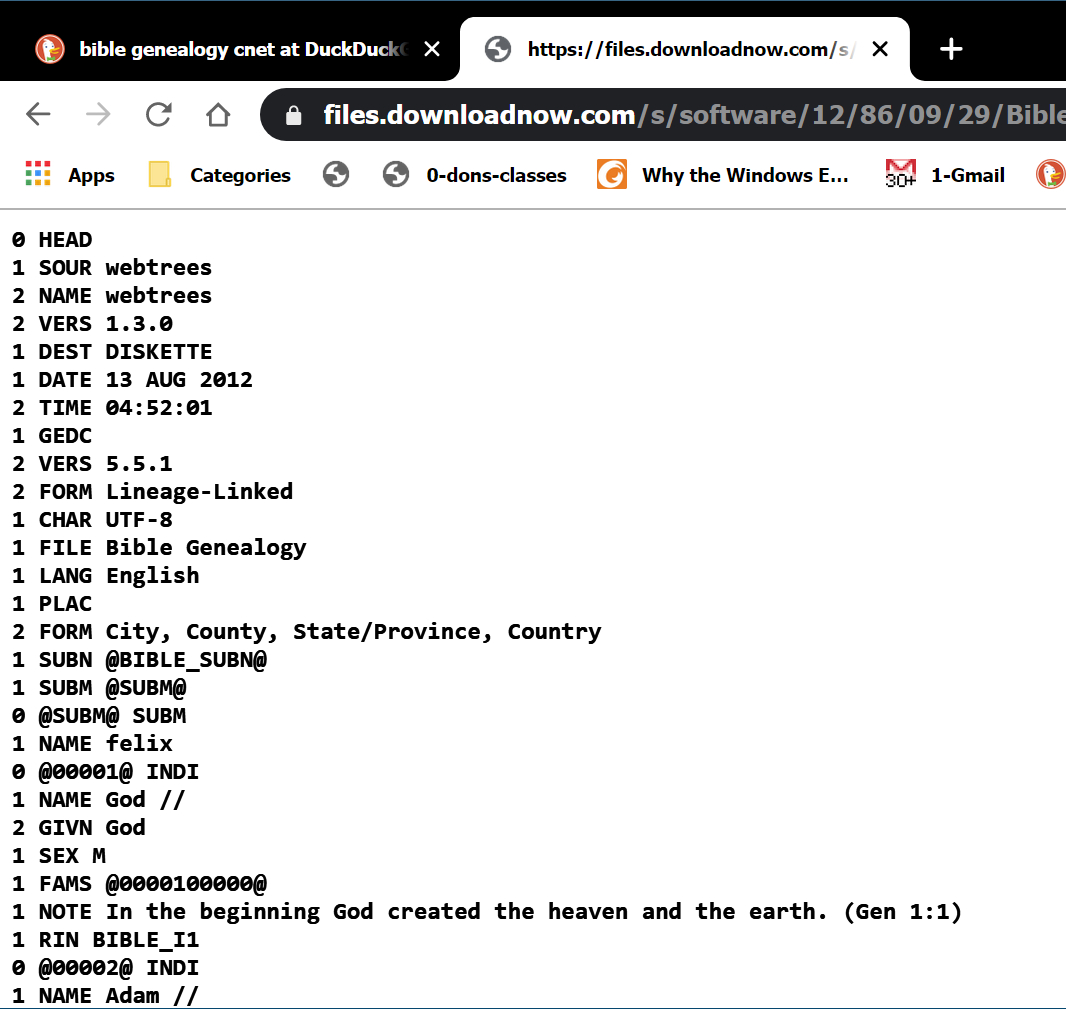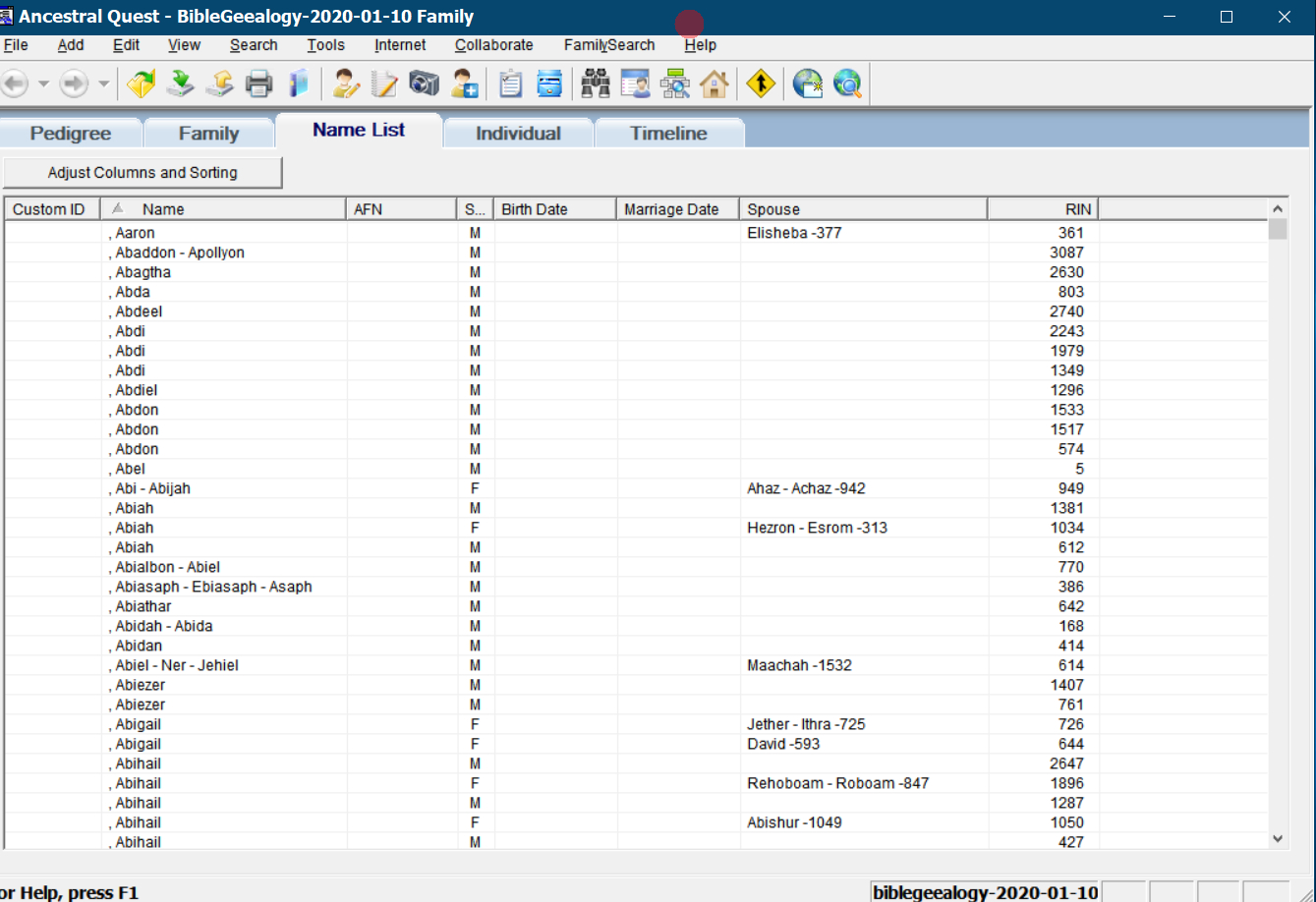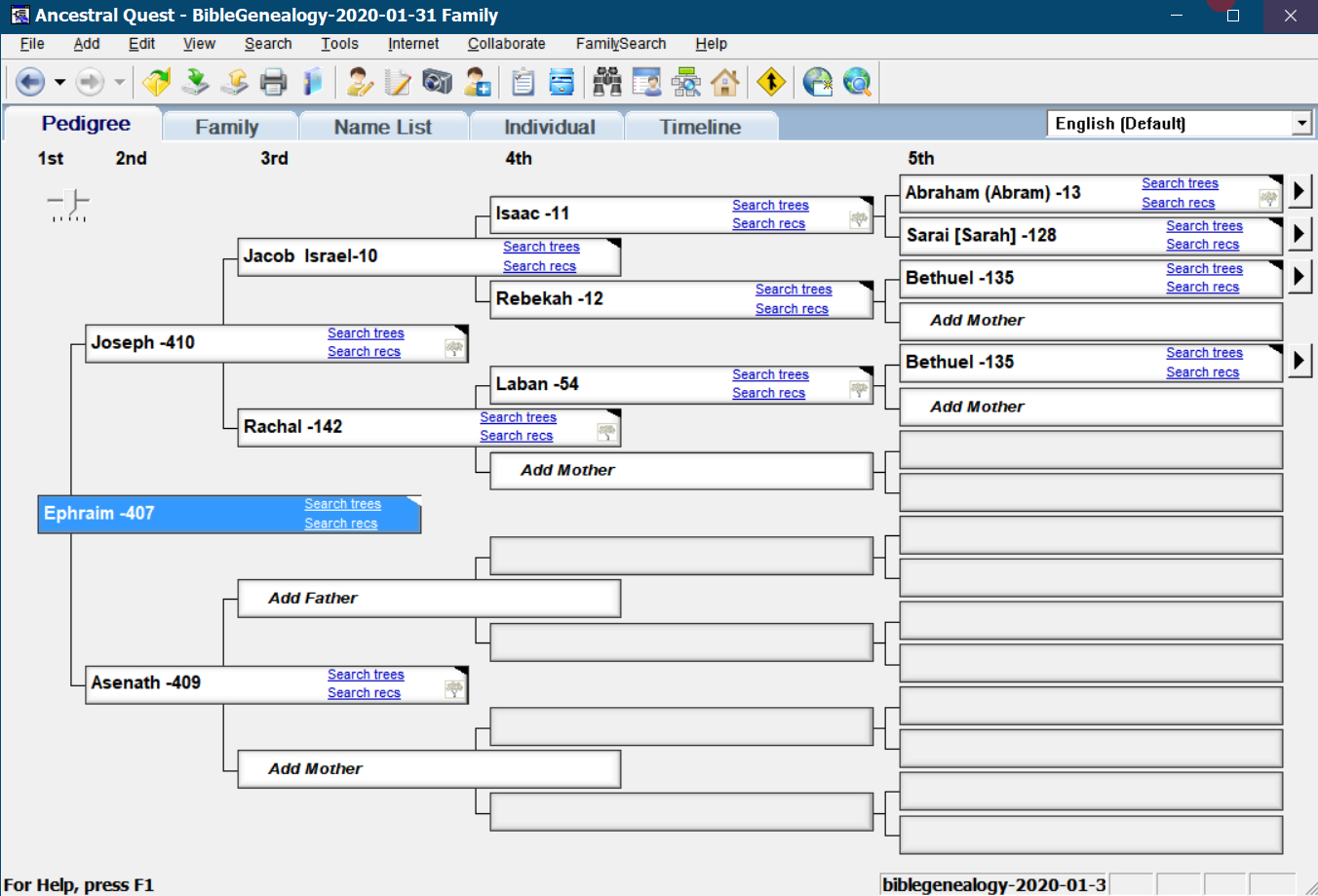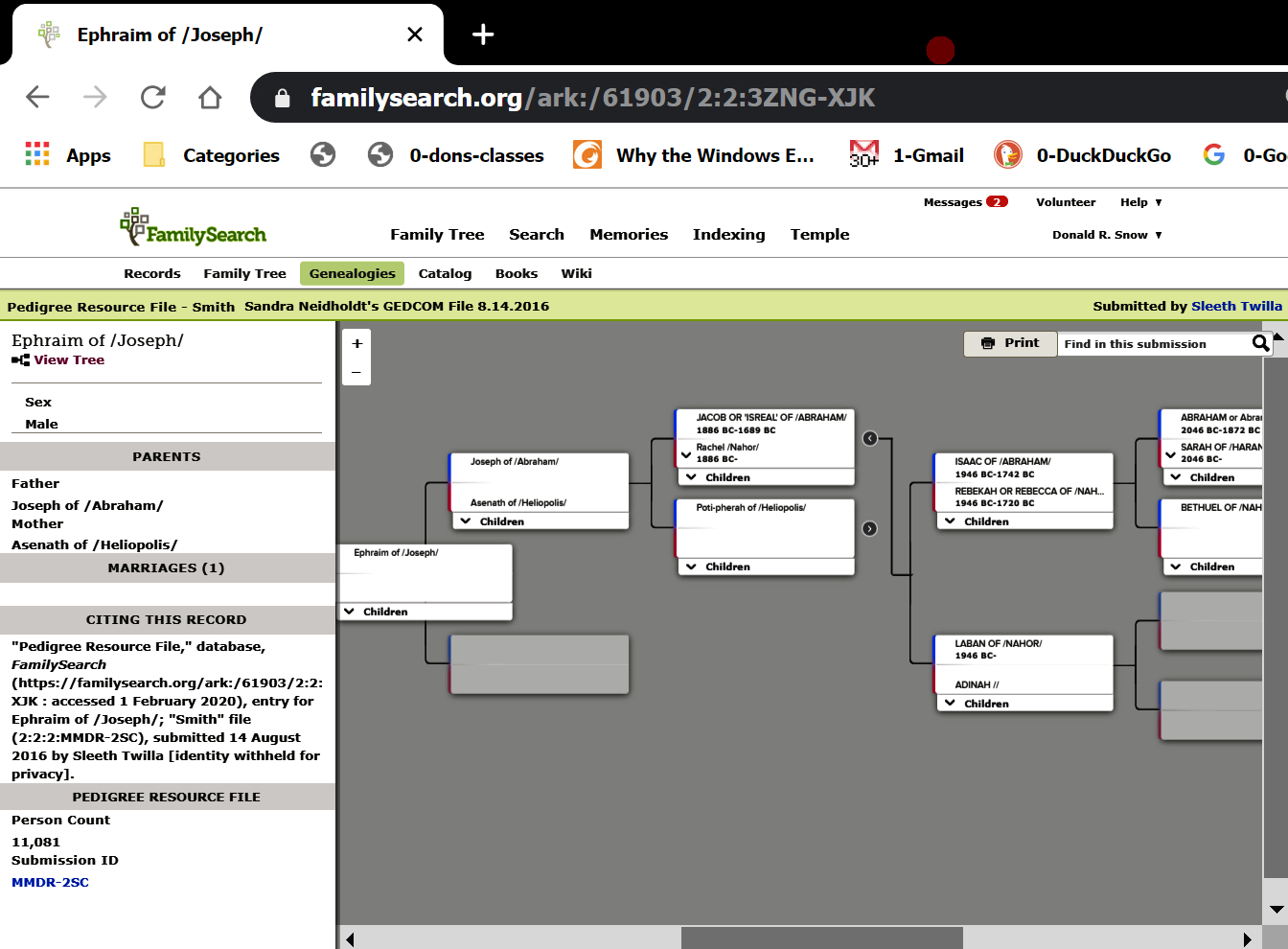DON'S FREEWARE CORNER - FEB 2020
BIBLE GENEALOGY
Don's Freeware Corner articles are printed in the UTAH
VALLEY TECHNOLOGY AND GENEALOGY GROUP (UVTAGG) Newsletter
TAGGology each month
and are posted on his Class Notes Page
https://uvtagg.org/classes/dons/dons-classes.html
where there may be corrections and updates.
BIBLE GENEALOGY
©2020 Donald R. Snow - Last updated 2020-02-10
THE BIBLE
While reading the Bible recently, I wondered if there were some
way to visualize all the family relationships that it has
and I thought about starting a genealogy database of
all the names in the Bible, myself. Then it occurred
to me that probably someone has already done that, so I
started looking. I thought that if I could find a
GEDCOM file of that data, I could open it in Ancestral Quest
or any other modern genealogy program. This article contains
the results of that search.
RESULTS OF A DUCKDUCKGO SEARCH FOR BIBLE GENEALOGY
DuckDuckGo is a search engine, like Google, but, unlike Google,
it doesn't track where you have looked, so I have it set
as my default search engine. Searching for Bible Genealogy
the first problem that came up was which Bible translation
to use, since there are many and the names may not be the
same in each. I looked for one that was closest to the
King James Translation and found several websites. The
next problem is that most of the hits relate to Bible
genealogy wall charts and that's not what I'm looking for.
Searching for ' "bible genealogy" .ged ' (without the outside quotes; .ged stands for GEDCOM)) brought up a
CNET website
https://download.cnet.com/Bible-Genealogy/3000-2135_4-75820205.html
.
Note: this plays a short video about freeware
which you can skip if you click on the Download Now button.
What you see is the first few lines of
a GEDCOM file of all the people in the Bible.
A GEDCOM file is a text file in a particular format that
can be imported into genealogy programs. Here is a
screenshot of the first few lines of it.

These are only the first few lines and it goes on for hundreds
of lines. Scrolling through it you see all the names
with notes about that name and the Bible reference of
where that name occurs. The GEDCOM tags are the words
at the left such as NAME, BIRT (birth), SOUR (source), etc.,
and those tell the genealogy program where that data goes.
Importing this GEDCOM into a genealogy program allows use of all the display features of the program
such as pedigrees and descendants views. My main
data entry database is Ancestral Quest, but RootsMagic,
Legacy, or Family Tree Maker, or any other genealogy
program, would also work. So how do you download the
GEDCOM, since there is no download button to click?
By experimenting on the website, I discovered that,
if you right click anywhere on the page and click
Save As, it offers to save the whole thing as a
text file, which it is, with the name
Bible_Genealogy_v1-0.txt . The extension .txt
shows that it is a text file. By changing the file
extension to .ged , either before or after saving it,
you get a valid GEDCOM file that can be imported
into a genealogy program. I imported it into
Ancestral Quest and all 3087 names and their relationships are now available
to examine. Here's a screenshot of the first part
of the name list from Ancestral Quest.

DISCUSSION OF THE DATABASE
This database seems to contain the names of everyone
mentioned in the Bible, but not the Apocrypha.
The scripture reference where the name occurs
in the Bible is shown in the notes and sources.
Some individuals have more than one name, e.g.
Noah - Noe, and it is not explained why, but
perhaps Noah is mentioned elsewhere in the
Bible besides Genesis 5:29 and his name is
spelled there Noe. When I first thought about compiling
such a database myself, I wondered how to handle
that problem and realized I needed a better
background of ancient languages and people.
But, without an explanation, I'm left wondering
if some of these might really be two separate
individuals. You notice that there are no
surnames and that's reasonable since surnames
only came into use a few centuries ago. So,
to search for a name, in this database you must start with ", "
[comma space] before the name. Before surnames
were used, sometimes to distinguish people, a
location was used such as "from" and that's where
we get names like van, von, de, etc. For an
interesting history of surnames see the Wikipedia
article at https://en.wikipedia.org/wiki/Surname .
I have found this database very helpful to show me
the relationships mentioned in the Bible.
Here's screenshot of Ephraim's ancestry from this database in Ancestral Quest.

OTHER BIBLE DATABASES
There are other databases containing Biblical genealogy and
some have been submitted as Community Trees on
FamilySearch. You get to these on FamilySearch
by going to Search > Community Trees. In
experimenting with finding some Biblical names
there, I searched the Pedigree Resource File
for Joseph son of Jacob and Rachel and found the
pedigree for Ephraim in this screenshot.

CONCLUSIONS
For these scripture databases it would be helpful
if they included an approximate time frame of
when the person lived, even if this were only a
relative time frame so you could tell who came
first, but that may be asking too much. It's
helpful to me just the way it is. Now I wonder
if anyone has done the same for the other
scriptures of the Church of Jesus Christ of
Latter-day Saints, e.g. the Book of Mormon,
Doctrine and Covenants, and Pearl of Great Price.
The other scriptures don't have as many people
mentioned by name; for example the Book of Mormon
only mentions four women by name, as I recall.
Most of the people mentioned in the Doctrine and
Covenants are listed in the Early LDS databases
which my wife and I worked
on this as an assignment in the Illinois Nauvoo Mission.
It's online at http://earlylds.com/ . My introduction can
be found by searching for Intro in the First Name field.
I hope you find these scripture databases as helpful as I have.
=====================================================
========



